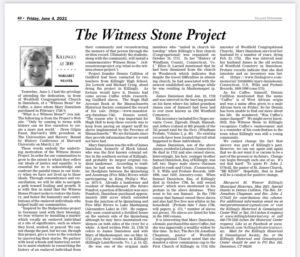From the Killingly Villager by Margaret Weaver on June 4, 2021
Yesterday, June 3, I had the privilege of attending the dedication, in front of Westfield Congregational Church in Danielson, of a “Witness Stone” for Cuffee, a slave whom Mary Danielson purchased in February 1728/9.
“What is a Witness Stone?” you ask. The following is from the Project’s Web site: “’Only by coming to terms with history can we free ourselves to create a more just world.’ – Drew Gilpin Faust, Harvard’s 28th president, at The Universities and Slavery: Bound by History Conference at Harvard University on March 3, 20.”
These words embody the underlying motivation of the Witness Stones Project. In order for our communities to grow to the extent to which they reflect our ideals of justice and equality, it is essential for us to acknowledge and confront the painful times in our history when we have not lived up to those ideals. Through remembrance and reconciliation, we will be able to navigate a path toward healing and growth. It is with this in mind that the Witness Stones Project seeks to restore the history, and honor the humanity and contributions of the enslaved individuals who helped build our communities.
“Inspired by the Stolpersteine project in Germany (and with their blessing), we bear witness by installing a marker which recalls an enslaved individual at a site of significance, such as where they lived, worked, or prayed. We cannot change the past, but we can, through this project, give a voice to the voiceless by uncovering their stories. We partner with local schools and historical societies to assist students in researching the history of an enslaved individual from their community and reconstructing the memory of that person through the written record. Ultimately the students, along with the community, will install a commemorative Witness Stone.” (witnessstonesproject.org/what-is-the-witness-stones-project/).
Project founder Dennis Culliton of Guilford had been contacted by two teachers from Killingly High School, Joe Lewerk and Michael Craig, about doing the project in Killingly. As fortune would have it, Dennis had come across Cuffee while researching Guilford slaves. The Hugh Hall Account Book at the Massachusetts Historical Society contained the record of his sale. (https://www.masshist. org/database/736). Dennis noted, “The reason why it was important for Hugh Hall to keep these records was to keep from paying an import tariff for slaves implemented by the Province of Massachusetts.” We are fortunate since they provide information that we would not have had.
Mary Danielson was the wife of James Danielson, formerly of Block Island, who was the first known colonial settler in the southern section of Killingly, and probably its largest original resident landowner. According to tradition he had seen the fertile, triangular floodplain between the Quinebaug and Assawaga (Five Mile) Rivers while participating in King Philip’s War, ca. 1675/6. Already a landowner and resident of Mashomoquet (the future Pomfret; a portion of Brooklyn was once Pomfret), Danielson purchased approximately 2000 acres which extended from the junction of he Quinebaug and Five Mile Rivers to Lake Mashapaug (Alexanders Lake) in 1707. He supposedly soon constructed a fortified house on the eastern side of the Quinebaug although he may have maintained residences on both sides of the river for a while. A deed written Febr. 23, 1709/10 refers to James Danielson and wife Mary of Mashomoquet; one on May 16, 1713 gives their residence as Killingly (Killingly Land Records, Vo. 1, p. 14; 42).
He was one of the original male members who “united in church fellowship” when Killingly’s first church (Congregational) was organized on October 19, 1715. In her “History of Windham County, Connecticut, Vo. I,” Ellen D. Larned mentioned that he had been dismissed from the church in Woodstock which indicates that despite the travel difficulties in attending church, he had associated with the nearest established one, perhaps while he was residing in Mashomoquet (p. 170).
James Danielson died Jan. 22, 1728 and was interred in the burying ground on his farm where his infant grandson James (son of Samuel) had been laid to rest (now known as Old Westfield Cemetery).
His inventory included five Negro servants: Cesar, Ziproah, Dinah, Hannah, and Jethro (valued at 600 pounds of the 725 pound total for the five). (Windham Probate, Volume 2, p. 48). No existing records have been located that tell what happened to these individuals.
James Danielson, son of the above James, resided in Lebanon, Connecticut. He died in 1752 and also owned slaves. Interestingly, his heir, younger brother Samuel Danielson, Esq. of Killingly, was left two Negro male slaves—Nacman (hard to read) and Crisis. (Connecticut, U. S. Wills and Probate Records, 1609- 1999, case 1059; Ancestry.com). When Samuel Danielson, Esq. of Killingly died in October 1786, he still owned slaves*, which were mentioned in his probate in the above database. They went to his son Samuel. In the 1790 census that Samuel owned three slaves and also had five free non-whites in his household. (Probate date 7 June 1786, will papers, p. 175; * number of slaves not given). No slaves are listed for him in the 1800 census.
It is interesting that Mary Danielson, a female, purchased the slave Cuffee, but she was apparently a wealthy widow by this time. In fact, The Rev.Dr.Jonathan Chapman, pastor of Westfield Congregational Church noted that she donated a silver communion cup to the First Church of Killingly in 1732 (the ancestor of Westfield Congregational Church). Mary Danielson survived her husband by a number of years, dying Feb. 23, 1752. She was interred near her husband James in the old section of Westfield Cemetery in Danielson. Probate records indicate that she died intestate and no inventory was listed. (https://www.findagrave.com/ memorial/104566904/mary-danielsonn; Connecticut, U.S., Wills and Probate Records, 1609-1999 (case 573).
As for Cuffee, himself, Dennis Cullliton mentioned that the name “Cuffee” is of West African origin and was a name often given to a male African born on Friday. So far Dennis has been unable to find out more about his life. He wondered, “Was Cuffee’s name changed?” We might never know. Still, this Witness Stone in Killingly recognizes Cuffee’s enslavement and is a reminder of his contribution to the town when Killingly was still a young community.
We cannot change the fact that slavery was part of Killingly’s past. However, we can say again and again that we do not want it or racism to be a part of the present or its future. Change can begin through each one of us. It’s not that hard! To quote Fr. John J. O’Neill, the pastor of St. James Church, “BE KIND!” Hopefully, that in itself will be a catalyst for positive change. Margaret M. Weaver Killingly Municipal Historian, May 2021. Special thanks to Dennis Culliton, The Rev. Dr. Jonathan Chapman, and Rev. John J. O’Neill for contributions this column.
For additional information email me at margaretmweaver@gmail.com or visit the Killingly Historical & Genealogical Center Wed. or Sat. 10-4 (when it reopens) or www.killinglyhistorical.org. or call 860-779-7250 (when the Historical Center reopens). Like us at Facebook at www. facebook.com/killinglyhistoricalsociety. Mail for the Killingly Historical & Genealogical Society, Inc. or the Killingly Historical and Genealogical Center should be sent to PO Box 265, Danielson, CT 06239.



